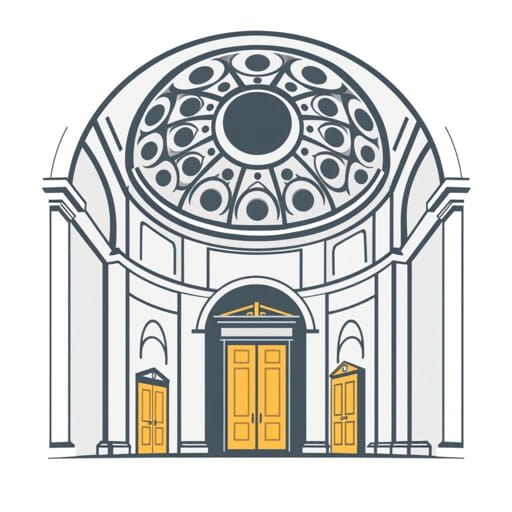Inside the Baptistery Florence
Inside the Baptistery in Florence, visitors are met with a space that transcends time. Located opposite the Florence Cathedral, the Baptistery of San Giovanni is one of the oldest buildings in the city and holds centuries of history, art, and spiritual symbolism. Stepping inside, one is immediately surrounded by intricate mosaics, architectural grandeur, and the weight of religious significance. This sacred space has witnessed the baptism of many notable Florentines, including Dante Alighieri, and continues to inspire awe through its harmonious blend of Romanesque design and Byzantine decoration.
Architectural Design and Layout
The interior of the Florence Baptistery is defined by its octagonal shape, a form rich in Christian symbolism. The number eight represents regeneration and rebirth, perfectly aligning with the building’s purpose as a place of baptism. Each of the eight sides contributes to the structure’s symmetry and balance, enhancing the contemplative nature of the space.
Columns and Marble Inlay
The walls of the baptistery are adorned with alternating bands of white and green marble, sourced from Carrara and Prato respectively. Corinthian columns and pilasters divide the interior into panels, each of which is decorated with geometric patterns and stylized designs. These architectural elements draw the eye upward and convey a sense of vertical movement toward the heavens.
Domed Ceiling
Above, the ceiling forms a massive octagonal dome that dominates the space. It is divided into concentric levels, culminating in a central oculus. The ceiling’s structure is both a technical and artistic marvel, supporting elaborate mosaics while guiding light throughout the chamber. This architectural feature plays a vital role in highlighting the artistic works that follow.
Mosaic Masterpieces
The mosaics inside the Florence Baptistery are perhaps its most celebrated feature. Covering the interior of the dome and parts of the walls, these mosaics were created between the 13th and 14th centuries by a variety of artists, including Cimabue and the Venetian masters.
Depiction of the Last Judgment
The central composition on the ceiling is the Last Judgment, occupying the largest segment of the dome. Christ the Judge dominates the scene, flanked by angels, saints, and scenes of heaven and hell. The figure of Satan consuming the damned is particularly vivid and often noted for its dramatic effect.
- Christ: At the center, radiating divine authority and surrounded by golden light.
- Angels and Saints: Ordered in concentric bands, offering praise and judgment.
- Hell: Rendered with disturbing imagery of demons and punishment, providing moral instruction to viewers.
This mosaic cycle was intended to educate the faithful on Christian theology and the consequences of their moral choices. It remains one of the most powerful visual narratives in medieval art.
Scenes from Genesis and the Life of Joseph
Below the Last Judgment, additional bands of mosaics depict stories from the Book of Genesis, including the Creation, Adam and Eve, and Noah’s Ark. These stories are rendered in vivid colors and expressive figures, emphasizing divine creation and human fallibility.
The story of Joseph, shown in later mosaics, brings themes of forgiveness, family, and providence, all rendered in a rich storytelling style that blends Eastern and Western artistic traditions. The vivid scenes serve both a decorative and didactic purpose.
The Baptismal Font
At the center of the baptistery originally stood the baptismal font, though today the exact placement is reconstructed. The font was used for full-immersion baptisms, a practice common until the later Middle Ages. While the current font is not the original, the idea of centrality reflects the focus on spiritual rebirth through water.
Liturgical Function
The Baptistery was not merely a ceremonial space but served an essential liturgical function in medieval Florence. All citizens were baptized here before being accepted into the Christian community. The building thus marked the spiritual birth of every Florentine, reinforcing its role as a civic and religious cornerstone.
Floor Design and Symbolism
The floor of the Baptistery is another artistic achievement. Composed of marble inlay, it features geometric patterns, zodiac signs, and symbolic references. Some scholars believe the floor aligns with celestial or liturgical calendars, suggesting a deeper cosmological significance.
One prominent design includes interlocking circles and star patterns, which may represent eternity and divine order. These elements complement the vertical symbolism of the dome and reinforce the unity of heaven and earth within the sacred space.
The Bronze Doors and Their Interior Presence
Although most visitors associate the Baptistery with its famous bronze doors, such as the Gates of Paradise by Lorenzo Ghiberti, their effect is also felt from the inside. The doors serve not just as decorative entrances but as spiritual thresholds, marking the transition from the secular world into the sacred interior.
Spiritual Gateway
From the inside, these doors frame the view outward, symbolizing the believer’s journey from baptism and spiritual renewal toward the world outside. This orientation reinforces the building’s message of transformation and mission.
Acoustics and Atmosphere
The Baptistery’s domed ceiling and marble surfaces create a unique acoustic experience. Sound echoes gently within the space, giving even whispered prayers or hymns a sense of resonance and solemnity. The interplay of light filtering through narrow windows adds to the spiritual ambiance, making the interior feel otherworldly.
These elements combine to produce an atmosphere that encourages reflection, devotion, and awe. The building’s layout, decoration, and sensory qualities were carefully designed to uplift the human spirit and focus attention on the divine.
Inside the Baptistery of Florence, every architectural element and artistic detail contributes to a rich tapestry of faith, art, and history. From the soaring dome covered in golden mosaics to the geometric precision of the floor, the interior presents a vision of divine order and sacred storytelling. The role of the Baptistery as a site of baptism, spiritual instruction, and civic identity continues to resonate with visitors today. As one of Florence’s most iconic religious buildings, its interior stands as a testament to the skill of medieval artists and the enduring power of sacred architecture.
